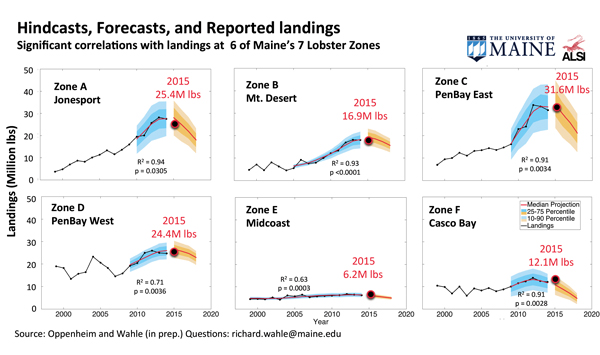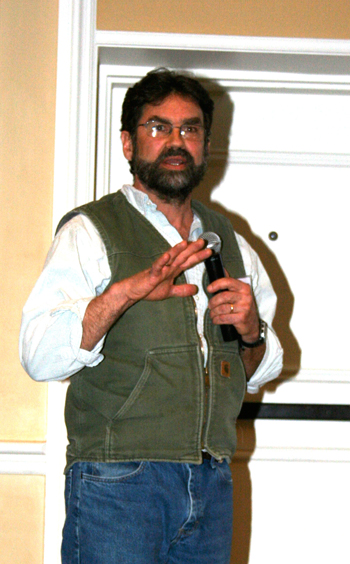Lobster Boom: How Long Can it Last?
continued from April 2016 Homepage

The decline in landings hasn’t affected the fishery’s value. The average per pound value increased by more than 10 percent, going from $3.70 per pound in 2014 to $4.09 per pound in 2015. And overall value jumped by more than $37 million, reaching $495.4 million. When factoring in bonuses paid to harvesters as reported by 11 of Maine’s 19 lobster co-ops, overall landed value reached $510.6 million.
“Despite that huge surge in value, we seem to be just starting to fall off that massive peak in landings,” said Rick Wahle, a scientist with the University of Maine’s Darling Marine Center, during a session on the topic at the recent Maine Fishermen’s Forum.
Wahle spoke to “the amazing surge in abundance” seen in Maine for the past decade.
Warming waters in the Gulf of Maine could be contributing to the surge, he said. According to a study now in the works by Maine Sea Grant, the University of Maine, the Department of Marine Resources (DMR), and participating lobster fishermen, the lobster population has expanded north and east, and down into deeper water—areas historically deemed too cold for larval development.
As lobsters moved north, fishermen experienced a four-fold increase in harvest. Fishermen and scientists speculate that temperatures may have warmed enough to increase the area of favorable nursery habitat. The collaborative study is looking at whether the unprecedented surge in small lobsters in the historically cold eastern and deeper parts of the Gulf of Maine in the last decade is the result of expanded settlement—lobster larvae settling in deep, offshore waters—or juvenile lobsters settling in shallow nurseries and then moving into deeper water.
“This is an important distinction, because it has implications for the carrying capacity and production potential of coastal nursery habitats,” according to the study abstract.
The DMR carries out a number of different types of monitoring programs to study lobster at different life stages. These include sea sampling, ventless trap surveys, inshore trawl surveys, and settlement surveys.
Settlement surveys are conducted when SCUBA divers sample sections of the seabed, counting the number of baby lobsters present. The numbers contribute to the Lobster Settlement Index—a measure of the annual pulse of baby lobsters five to nine years before they appear in the fishery.
Initiated in 1989, the index has expanded from Maine south to Rhode Island and north to Newfoundland. More than 100 sites from all regions are sampled annually.
This program is considered to be a possible early warning system for trends in the fishery. Projections are validated against observations from landings statistics or independent trawl surveys, for example, by looking at three regions with the longest data records.
During the validation process, it was found that the predictive model sync’d up well with observed landings in six of Maine’s seven lobster zones. And that means there’s some confidence in stating the model’s projection of a settlement downturn, particularly in easternmost Zones A through C, with a softer downturn to the west, said Wahle.
The survey shows there’s a bubble in settlement from 2005-2008, especially in eastern Maine.

“We’ve been falling off that since then,” Wahle said. “The 2015 numbers are well below average over most of the coast of Maine. The Massachusetts numbers are very low as well. So—a pretty wide downturn in settlement.”
However, there are some uncertainties in the model, he said.
One is whether or not there’s an increasing level of settlement in deep water.
So Wahle and collaborators have developed a new type of sampling device to get to areas inaccessible to divers.
Working with participating fishermen, Wahle will deploy rock-filled, passive “collectors” on the sea floor to collect newly settled juvenile lobsters, in parallel with Maine’s ventless lobster trap survey of older juveniles. Juvenile lobsters will be sampled, and water temperature monitored, at 15 sites at three different depths in the eastern and western Gulf of Maine.
“Our goal is to use the larval settlement index, as well as relative environmental indicators, like temperature and shell disease, as predictors of fish recruitment,” he said. “This is a challenge. Trying to follow year classes through time is not like trees, which have growth rings. It’s hard to age them. So you try to follow cohorts based on our understanding of growth rates.”
The collectors are basically wire mesh trays full of rocks.

“We’re starting to open a window on settlement in places we haven’t been able to go before.” – Rick Wahle, Darling Marine Center, Walpole, Maine Laurie Schreiber photo
“We’re starting to open a window on settlement in places we haven’t been able to go before,” Wahle said.
That information, he said, can be run through a prediction model that also brings in biological and environmental variables such as size, age, water temperature, and shell disease, although currently, in Maine, shell disease is not a big issue.
Another uncertainty is whether the model incorporates the proper functions related to lobster biology, such as growth, disease, and mortality.
Lastly, it’s unclear whether landings themselves are an accurate indictor of recruitment.
“We think they are, because all you guys out there, sampling all those lobsters, are an amazing source of data and an indicator of number of lobsters entering the population every year,” Wahle said. “Plus we have fishery-independent surveys” conducted by the Department of Marine Resources.
Ultimately, he said, if settlement is an accurate predictor of recruitment to the fishery, “then we expect landings to fall in some areas, especially in the east.” But it’s important to note, he said, that broodstock is probably at a historic high, and yet settlement is declining.
“So what’s the disconnect? Where does that disconnect come from?” he said. “It probably has to do with the physical environment. There’s just not a smoking gun there that we can link that disconnect to. We do not have a crystal ball. All these models are abstractions of the real world. So we have to acknowledge these uncertainties and the data gaps and the untested assumptions, and we have to consider all the indicators of population health, like the ventless trap survey and trawl survey, and weigh their merits as we move forward.”
If the predictive model is accurate, he said, it could add important lead time, putting the future of the fishery more firmly in the hands of fishermen: “As fishermen, that gives you the time, for example, to decide whether it’s worth it to invest in a new boat or, as a dealer, to open that new building for processing.”
